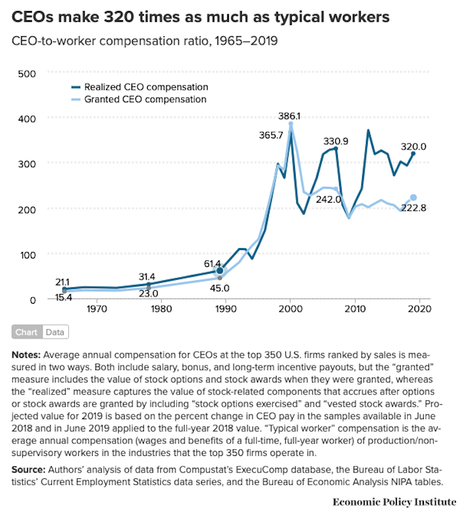
The chart above is from the Economic Policy Institute (EPI).
In 1978, the average CEO made about 31.4 times the pay of the average worker. That was because increasing productivity was shared by both CEO's and workers. But in the 1980's, the Republicans were able to change the economic landscape in this country. They initiated their "trickle-down" economic theory -- which said that giving more to the rich would benefit everyone, because much of that money would trickle down to workers.
But it did not work out as they promised. Since 1978, CEO pay has grown by 1167% (and CEO's raised the pay of other executives to justify the rise in their own pay), while the pay of workers grew by only 13.7%. This created a huge gap between the rich and the bottom 90% of Americans -- a gap that has grown as large as before the Great Depression, and keeps growing larger. It is turning th U.S. into a nation of "haves" and "have-nots" as it shrinks the middle class and increases the number of workers struggling to keep up.
The EPI has produced a report on this growth of CEO pay and it's relation to worker pay, and how it is growing the income and wealth gap. It's an excellent, but lengthy report, and well worth reading to see what is happening in our economy.
Here is a synopsis of that report, and why it matters:
Corporate boards running America’s largest public firms are giving top executives outsize compensation packages that have grown much faster than the stock market and the pay of typical workers, college graduates, and even the top 0.1%. In 2019, a CEO at one of the top 350 firms in the U.S. was paid $21.3 million on average (using a “realized” measure of CEO pay that counts stock awards when vested and stock options when cashed in rather than when granted). This 14% increase from 2018 occurred because of rapid growth in vested stock awards and exercised stock options tied to stock market growth. Using a different “granted” measure of CEO pay, average top CEO compensation was $14.5 million in 2019. In 2019, the ratio of CEO-to-typical-worker compensation was 320-to-1 under the realized measure of CEO pay; that is up from 293-to-1 in 2018 and a big increase from 21-to-1 in 1965 and 61-to-1 in 1989. CEOs are even making a lot more—about six times as much—as other very high earners (wage earners in the top 0.1%). From 1978 to 2019, CEO pay based on realized compensation grew by 1,167%, far outstripping S&P stock market growth (741%) and top 0.1% earnings growth (which was 337% between 1978 and 2018, the latest data year available). In contrast, compensation of the typical worker grew by just 13.7% from 1978 to 2019.
Exorbitant CEO pay is a major contributor to rising inequality that we could safely do away with. CEOs are getting more because of their power to set pay—and because so much of their pay (about three-fourths) is stock-related, not because they are increasing productivity or possess specific, high-demand skills. This escalation of CEO compensation, and of executive compensation more generally, has fueled the growth of top 1.0% and top 0.1% incomes, leaving less of the fruits of economic growth for ordinary workers and widening the gap between very high earners and the bottom 90%. The economy would suffer no harm if CEOs were paid less (or were taxed more).

